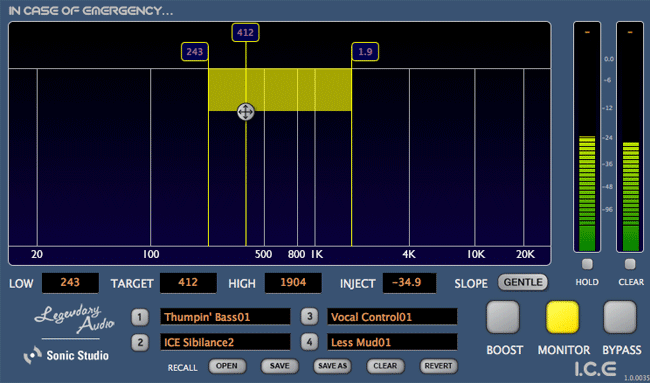Sonic Studio has announced the release of version 1.0 of I.C.E., a cross–platform signal processing plug–in.
The latest member of their diverse technology family, I.C.E. encapsulates some of the innovative techniques developed by veteran engineer Billy Stull of Legendary Audio. The plug–in has been realized by the programming team at Sonic Studio, creators of the first digital audio restoration suite, NoNOISE™, and the first high resolution digital audio workstation.
Modern recording usually employs digital methods on minimal timeframes, often with less than ideal results. Distortion, especially in the digital domain, can be a significant problem. By the time the material arrives at the mixing or mastering stage, it is difficult to recover from any damage done during production.
I.C.E is a different way of processing audio from commodity “restoration” software. Working in double precision, 64 bit space without using EQ or resynthesis, it reduces unwanted components within a sound file after it has already been recorded and processed. Problems that can be addressed include: undesirable distortion, “hot spots” and harshness, over modulation and overloads, sibilance, resonances, and “digititis” from lesser quality converters, DAWs and DSP. Although I.C.E was primarily designed to solve audio problems, it can also be used to mold music without the downside and limitations that EQ often entails.
Archival restoration is one of the toughest jobs in all of pro audio, and Edward Abbott has been bringing lost music out of the vaults for over two decades. The indie veteran has access to every repair tool in the marketplace but lately, I.C.E. saved his bacon. “It bailed me out of a mix that I’d been trying to salvage for over 20 years, one where the 2″ 16 track with Dolby A was horribly misaligned,” Abbott enthused. “Every individual track was so messed up, both EQ and dynamically, that recreating the mixes was honestly just an exercise in futility. Throwing ICE on both the electric bass and acoustic guitar tracks, I was able to correct enough of the problem frequency bands to make them sound like actual instruments again.” Abbott finds I.C.E.’s unique capabilities indispensable, saying “…nothing else, and I’ve tried everything, has had this much of a healing effect on these heretofore unrecoverable tracks.”
Billy Stull is also quite familiar with pro audio. Known for his bespoke mastering hardware, the Masterpiece Analog Mastering System designed in collaboration with and built by renowned British designer Rupert Neve, Stull created I.C.E. to tackle problematic content that crosses his console. “Being able to clean up and sculpt whatever comes in, track by track in Pro Tools or any other DAW, opens a whole new world of recording,” Stull said. The list of issues that I.C.E. can improve is legion, and the simple interface makes for fast work. “Removing digital or analog distortion to taste, boosting deficient frequency bands, removing an unpleasant area in the vocalist’s tone, or taming resonant frequencies on bass, piano, or boomy acoustic guitar is amazingly quick.” Another example Stull mentioned, shaping a vocal track with I.C.E. so it sounds like a more expensive microphone was used, proves that the software can more than pay for itself. “Don’t forget the I.C.E.,” Stull quipped.
I.C.E. is currently available for Mac (VST/AU/AAX) for $289 USD, or as part of the upcoming Sonic All Plug–ins subscription service. VST and AAX Windows support will roll out shortly in a version 1.1 maintenance release.
More information: Sonic Studio / I.C.E.


